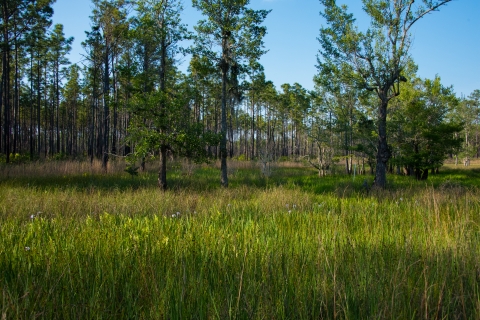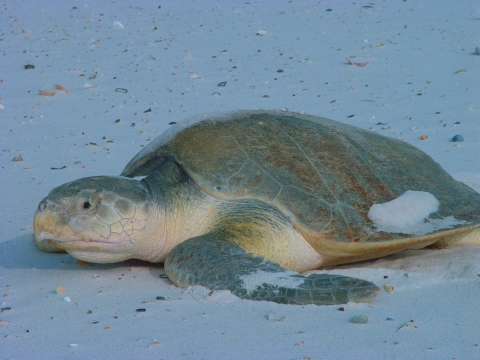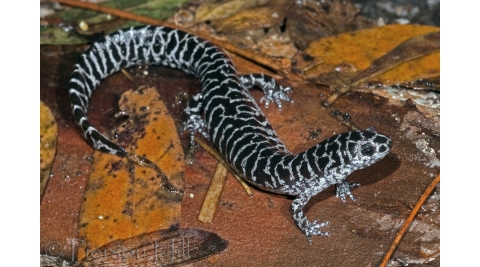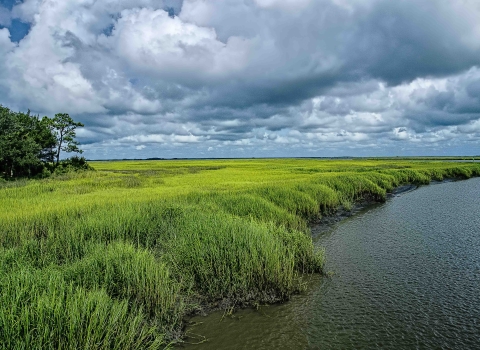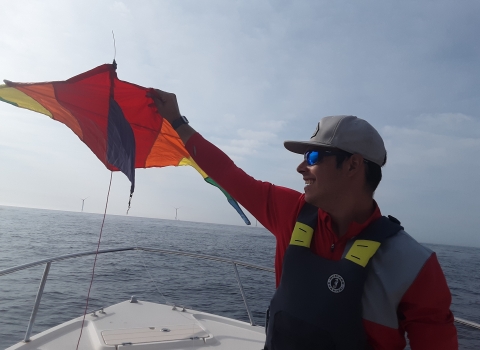With the release of Biden’s Executive Order 13990 and the 2021 report, Conserving and Restoring America the Beautiful, there’s a new emphasis on locally led landscape scale conservation across the Service. With various interpretations and unique regional dynamics, identifying what work is already being conducted within the Service and what opportunities remain untapped within locally led landscape scale conservation can be complicated.
To the Southeast Conservation Adaptation Strategy (SECAS) team, it’s about empowering local conservation players to find their place among a broad landscape of diverse interconnected ecosystems and human systems.
“Every single conservation action happens locally. There is no other place to do it except for on the ground,” says GIS support team member Amy Keister. “What we’re trying to do is coordinate all that local conservation toward contributing to a larger vision.”
Created in 2011, SECAS encompasses the 15 states and two territories of the Southeast Association of Fish and Wildlife Agencies (SEAFWA). The independent partnership serves the states and territories of SEAFWA and the federal agencies of the Southeast Natural Resource Leaders Group.
“SECAS is a partnership that represents the conservation institution of the Southeast,” says SECAS Coordinator Amanda Sesser. “It’s a way for the conservation institution to come together to think about how we can collectively create the landscape of the future. The Southeast Conservation Blueprint is a primary tool that we can use to get there.”
The Southeast Conservation Blueprint is a living, spatial plan that pulls data from across the Southeast and shows areas across the region that are important for the health, function, and connectivity of the landscape. The Southeast Conservation Blueprint is revised annually, taking into consideration the most recent available scientific data along with feedback provided by its users.
The SECAS team pulls many members from the Service and benefits from staff in their first year of conservation work and others with decades of experience. This mix helps the team work collaboratively to provide the best possible tool for conservation practitioners across the Southeast.
“I feel very fortunate to work on this team because we really work very closely together,” says user support specialist Alexandria Lamle. “It’s funny, I mean, we are spread out from New Mexico to the Atlantic Coast and everywhere in-between, but I talk to almost all of my coworkers at least once a week.”
The SECAS GIS team compiles existing data using a variety of natural and cultural resource indicators, which then identify areas of highest conservation priority in a comprehensive map to help guide conservation decisions in the region.
"It’s data development and data refinement to reflect partner priorities,” responds GIS team member Yvonne Allen when asked what her role consisted of. “I take the goals people are interested in and try to figure out how we can best map that to reflect that.”
With over 15 people on staff, the SECAS team works to not only develop the blueprint but assist those who use it.
“I work with partners in the region to help find themselves in the blueprint,” says Christopher DeVore, a user support specialist. “Whether that’s if they have questions relating to how they fit in the bigger picture, the landscape, or they have questions about what other people in the partnership are doing.”
The Southeast Conservation Blueprint is used across over 130 organizations, including state agencies, land trusts, federal agencies, local governments and planning organizations, nonprofits, conservation partnerships, private businesses, and universities. These partners utilize SECAS’ free user support services for a variety of needs, including but not limited to technical assistance on grant proposals, guidance on State Wildlife Action Plan revisions and basic interpretation of the Blueprint itself.
“Conservation is an innately human problem,” says Hilary Morris, blueprint user support and communications specialist. “It’s not that we don’t understand the science; it’s that we don’t understand the people and what people care about and how to influence their behavior.”
Approaching conservation on a landscape scale can help fit local conservation actions into a bigger narrative. The Southeast Conservation Blueprint is a tool to help tell these stories -- Why is this parcel of land important for conservation? How does it fit into the larger Southeast landscape? Those who work in SECAS User Support help write that story for partners to assist in their decision-making processes.
What sets the Southeast Conservation Blueprint apart from other landscape scale initiatives is its consistent iteration process. User Support and the GIS team continuously work alongside each other to adapt the Blueprint as new feedback comes in.
“I’m working with user support to find out where are the limitations, where is the blueprint not working, and then what can I do on the data side to address those,” Keister says.
Through its annual review process, the SECAS team has received feedback that assisted in the development of indicators that address inequities found within conservation. A new cultural indicator named Equitable Access to Potential Parks identifies areas with limited access to nature and highlights those areas where the creation of parks could benefit those communities.
“There are gaps that we need to fill, and we need to do so in a way that we ask ourselves: who are we serving and are there communities and groups of people who have been historically marginalized, who have been left out of these types of partnerships,” Sesser says. “How do we better integrate them in a meaningful way, not just to check the box way, but in a meaningful way?”
SECAS aims to provide added capacity for its partners, especially historically underserved communities. In light of the recent call for proposals for the National Fish and Wildlife Foundation’s America the Beautiful Challenge grant program, the SECAS team has been supporting Tribes, as well as other partners in the region, in their proposals. This program coordinates funding from federal agencies and private sources to support locally led, voluntary ecosystem restoration projects. The SECAS team uses the Southeast Conservation Blueprint to provide the scientific justification of why the proposed conservation actions are important not only for the local area but for the entire landscape.
In the future, the SECAS team hopes to continue to actively support historically underserved and marginalized communities. Todd Jones-Farrand, SECAS species liaison and user support specialist, says the team’s excitement to be expanding the Southeast Conservation Blueprint to better serve Puerto Rico and the U.S. Virgin Islands in the upcoming year.
“It’s not just about wildlife,” concludes Jones-Farrand. “It’s also about people.”
This story is part of our Open Spaces blog.


